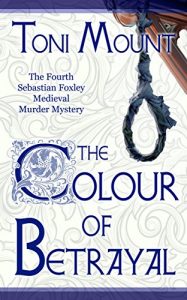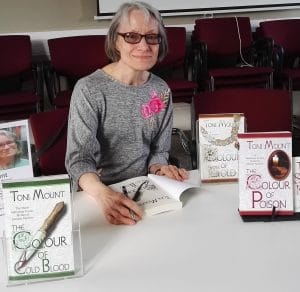 Welcome to historian and author Toni Mount who is visiting the Anne Boleyn Files as part of her book tour for her latest medieval mystery. The Colour of Betrayal is the latest whodunit in Toni’s popular Sebastian Foxley series of medieval murder mysteries. Inspired by a true story from the thirteenth century, this new tale involves the murder of a London goldsmith while he is ‘in sanctuary’ at St Mary-le-Bow church in London.
Welcome to historian and author Toni Mount who is visiting the Anne Boleyn Files as part of her book tour for her latest medieval mystery. The Colour of Betrayal is the latest whodunit in Toni’s popular Sebastian Foxley series of medieval murder mysteries. Inspired by a true story from the thirteenth century, this new tale involves the murder of a London goldsmith while he is ‘in sanctuary’ at St Mary-le-Bow church in London.
Over to Toni…
The church of St Mary-le-Bow dates from before 1090 and has always been at the heart of life in the City of London, being situated in Cheapside, the old city’s main east-west thoroughfare. From the beginning, it was linked with the Archbishop of Canterbury and as the principal ‘London Peculiar’ was the archbishop’s London headquarters. But the first Norman church didn’t last long. In 1091, the roof blew off, landing in the street during a huge storm which hit the south of England that winter. Then, in 1196, a famous siege took place at St Mary’s and in 1271 the church tower collapsed.
In the eleventh century, St Mary-le-Bow was known as St Mary Newchurch because just two hundred yards away is its near neighbour St Mary Aldermary (Older Mary). In medieval times the ‘square mile’ of the city, still bounded by the Roman city wall, was the whole of London, stretching from Ludgate in the west to Aldgate in the east. This densely populated area, where thousands of people lived in close proximity, was divided into wards and parishes, each having its own church. Today’s seat of government at Westminster was then a long walk from the city, through fields and pastureland, with villages like Holborn and Charing – with its famous Cross – along the way.
The world famous Bow bells are woven into the folklore of the City of London. In 1392, Dick Whittington supposedly heard Bow bells calling him back to London to become Lord Mayor. To be born within the sound of Bow bells is the sign of a true Londoner but my more recent research disputes the notion that this was the origin of the c*ckney – which is a medieval and Tudor word to describe a spoilt child.
The Great Bell of Bow which ends the medieval nursery rhyme ‘Oranges and Lemons’ refers to the largest of St Mary’s bells. The first official record of Bow bells is in 1469 when the Common Council ordered that a curfew should be rung at 9 o’clock each evening. It also marked the end of an apprentice’s working day and the practice continued until 1876. Soon after the setting up of this curfew, John Donne, a mercer, gave property in Bow Lane to St Mary’s to help pay for the maintenance and regular ringing of the bells. By 1512, the tower had been fully rebuilt and William Copland, a churchwarden, gave a great bell to the church making a total of five. Sadly this bell was rung for the first time for Copland’s own funeral.
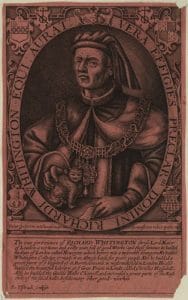
Richard (Dick) Whittington was born in Gloucestershire in the middle of the fourteenth century and found his way to London. The earliest mention of him in the city was in 1379 when he contributed 5 marks to a municipal loan. The famous nursery rhyme account of his life has him arriving in the capital as a poor orphan, having heard that the streets were paved with gold. Being the victim of beatings by the cook in the household of a rich merchant, he escaped on the morning of All Hallows Day and left the city. As he rested at Highgate some five miles to the north, he heard Bow bells ring ‘Turn again, Whittington, thrice Lord Mayor of London’.
In reality, at this date, Whittington was already a successful mercer by trade and served as Lord Mayor on four occasions, firstly in 1396-97 and for the final time in 1419-20. As the son of a knight, Whittington was never very poor and there is no evidence that he kept a cat as a pet. However, since a ‘cat’ was also a medieval cargo ship, it is possible that he owned his own trading vessel, as many rich merchants did – a different kind of cat altogether. As well as serving as Lord Mayor, he was also a Member of Parliament and had been a Sheriff of London in 1393-94. He financed a number of public projects, such as drainage systems in poor areas and a hospital for unmarried mothers. His will left his fortune to form the Charity of Sir Richard Whittington that continues to assist people in need 600 years later.
Beneath the eleventh-century church of St Mary is the earliest known stone arched crypt found in any church in London. The ‘le-Bow’ in the church’s name refers to those arches, as does the Latin name Sancta Maria-de-Arcubus (arches), describing the unique design of the crypt. St Mary’s was the meeting place of the medieval ‘Court of Arches’ – a church court which heard cases involving marriage, whether broken betrothals, unfulfilled promises of marriage, bigamy, annulments or the separation of spouses. [In a later adventure, Seb Foxley’s brother, Jude, is threatened with an enforced appearance at the Court of Arches to resolve an important case against him.]
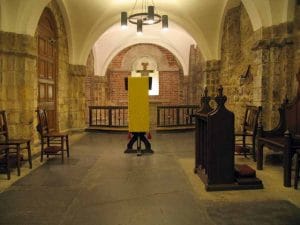
Though at one time the court moved to Westminster, that relocation was temporary and subsequently reversed so the Court of Arches today still meets at St Mary-le-Bow. This ecclesiastical court of the Church of England covers the Province of Canterbury and every new bishop in the south of England still receives confirmation of their election at St Mary-le-Bow. Here, they also take the Oath of Allegiance in the presence of the Archbishop of Canterbury, prior to their enthronement.
In September 1666, when the Great Fire raged through London, the whole of the medieval St Mary’s church, apart from the crypt beneath, was utterly destroyed. Between 1670 and 1683, it was rebuilt by Sir Christopher Wren. In the 1750s, a new peal of ten Bow bells was installed, with all of them being rung together for the first time on 4th June 1762 to mark the twenty-fifth birthday of King George III.
The Colour of Betrayal
Suicide or murder?
As medieval Londoners joyously prepare for the Christmas celebrations, goldsmith Lawrence Ducket is involved in a street brawl. Fearful that his opponent is dying from his injuries, Lawrence seeks sanctuary in a church nearby.
When Ducket is found hanging from the rafters, people assume it’s suicide. Yet, Sebastian Foxley is unconvinced. Why is his young apprentice, Jack Tabor, so terrified that he takes to his bed?
Amidst feasting and merriment, Seb is determined to solve the mystery of his friend’s death and to ease Jack’s fears.
Toni Mount is a popular writer and historian; she is the author of Everyday Life in Medieval London and A Year in the Life of Medieval England (published by Amberley Publishing) and several of the online courses for www.medievalCourses.com. Her successful Sebastian Foxley series of medieval whodunits is published by MadeGlobal.com and the latest book in this series The Colour of Betrayal, a novella, is now available as a paperback or on Kindle – go to myBook.to/Col_Betrayal to find out more.
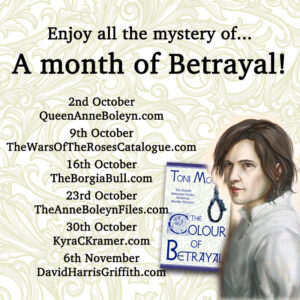
Pictures: Toni Mount at a book signing; Vera Effigies or “True Portaicture” of Richard Whittington, engraving by Renold (or Reginald) Elstrack (1570 – after 1625). Original engraving depicted a skull under his palm, but printseller Peter Stent requested it changed to a cat, to meet popular expectations. Source: Wikipedia, public domain.
St Mary-le-Bow, Cheapside, City of London EC2V 6AU – Crypt Chapel, cc-by-sa/2.0 – © John Salmon – geograph.org.uk/p/426561.
